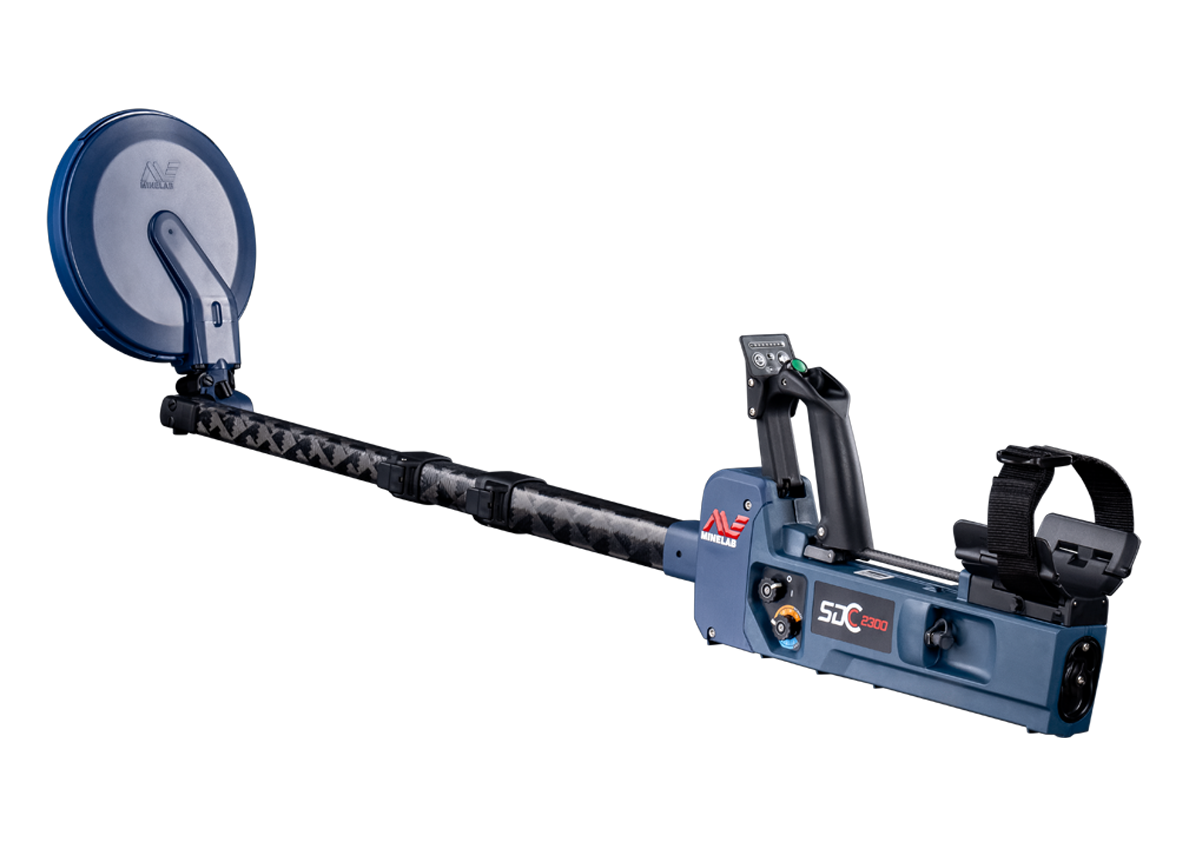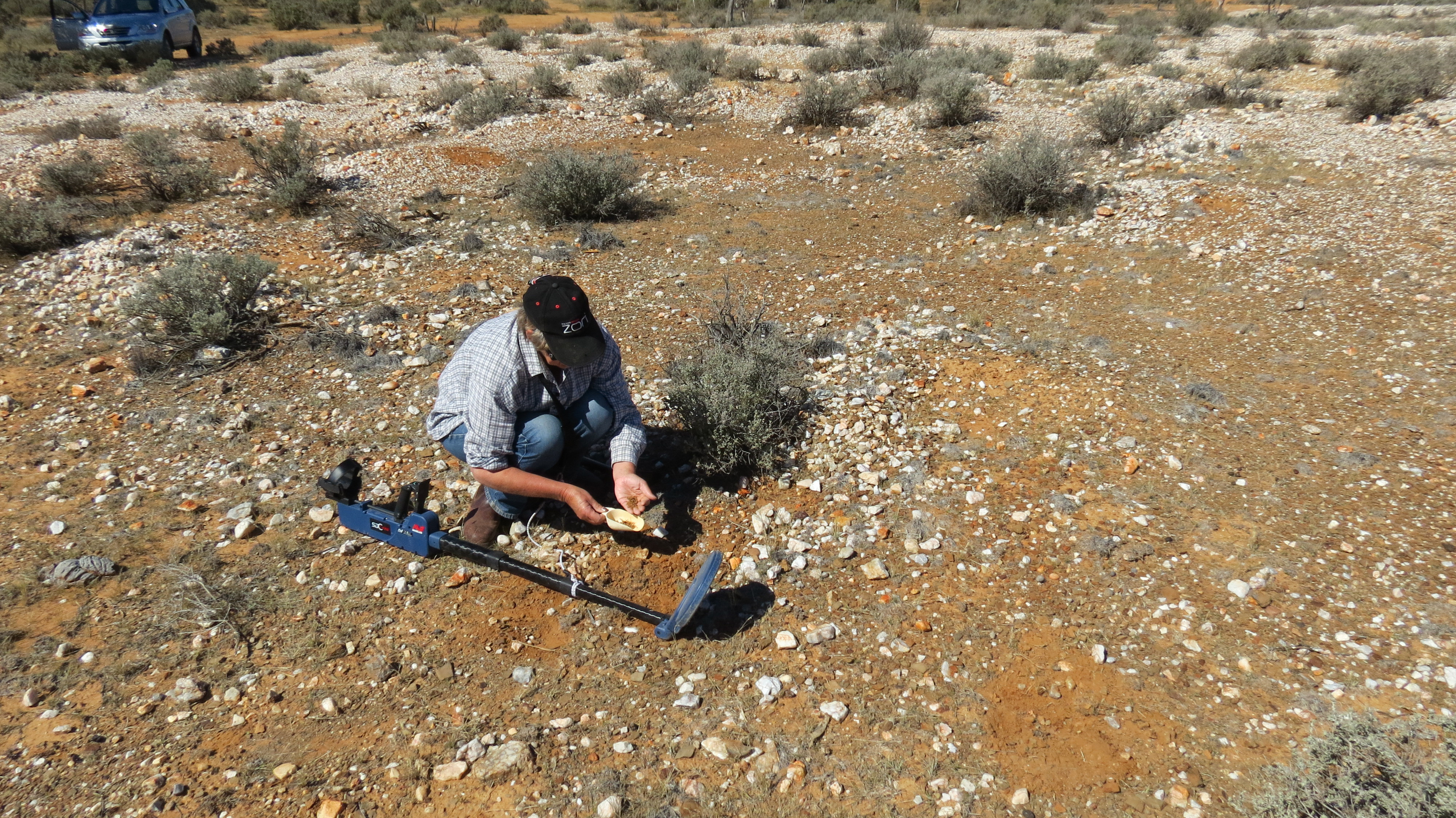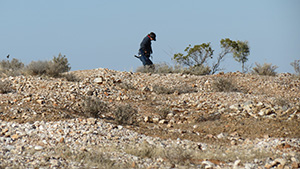Last year we actually sold all our detecting gear. We had been gold detecting for thirty four years and had decided that was enough. Then Minelab released the SDC2300. We then reckoned that trying to give up gold prospecting was akin to trying to give up breathing. So we bought a SDC 2300 and headed for Tibooburra.
Why Tibooburra? The Corner Country goldfields are well known for their small gold and it seemed a great spot to try out what Minelab said was the best detector yet for small gold. And we just love that country anyway. The road up from Broken Hill to Tibooburra hadn’t been graded for many months and was pretty rough but with only a total of one hundred kilometres out of a total length of 330km not sealed we soon got there. As on all roads simply driving to the conditions will ensure you can safely negotiate any road. Tibooburra hadn’t seen any worthwhile rain for about 18 months and the country was bare. While not good for the locals the lack of ground cover augured well for detecting. Checking in for a week at the caravan park we paid only $140.00 for a week instead of the normal $24.00 a night. While lacking green grass, sealed drives and kerbs this caravan park is indeed very good value, it has all the necessary amenities and is only a short stroll to the pubs and shops. As usual our first detecting spot was Fly Speck Hill out on the Common where we have been finding good gold for years. Unfortunately we could only find one little scrap that everyone else had missed. But over the back of the hill we did better. With only one detector we were taking it one hour each to detect. We found this a good way to go as it gave us a rest and enabled me to get my camera into action.
THE SDC2300
When we had first tried the detector the day we bought it we found it to be heavy and cumbersome to use. The folding armrest flopped down whenever you removed your arm and became a two hand job to get your arm back in. On top of that it was badly balanced and heavy to use. To combat these problems I used an old stubby holder, cut and glued to make the armrest more comfortable and to prevent the armrest from closing. The weight problem was soon overcome with a simple ockie strap attached at the lower stem clip. As the detector doesn’t come with a harness such as the GP and SD detectors I found an old shoulder strap off a sports bag and slung it over my shoulder bandolier style. With the hooks joined in the centre of my chest the strap became the support point for the ockie strap. That solved the weight and balance problem. These solutions were only rough and temporary. If they worked well I would then make something better when we got home. With the 2300 running well and causing neither of us any problems we continued to find gold. Another spot we’d always found gold was what we call Keith’s Hill after our friend who originally found it in 1992. In those days small gold was scattered all over the hill like golden dandruff. These days the hill still produces gold but of course much less. We did find two little patches that produced about 8 bits on each and a few scattered bits with the biggest being the one Cheryl found that weighed a mighty .6 of a gram. Over the next week and a half we wandered all over the Tibooburra Common. We detected a lot of new ground and found scattered gold. We detected amongst the old dry-blow heaps and found hundreds of tiny lead-shot that all the other detectors had missed, and some gold. It amazed us just how much lead shot was left out there. Admittedly it was mostly tiny but the 2300 gave a very good signal even on the tiniest shot. But what also amazed us was that almost all of the gold was shallow while some of the shot was very deep. We guessed that as the gold was mostly flat and the shot mostly round the shot sank quicker than the gold. We had been detecting the Common for over week and we were satisfied that the 2300 was without a doubt the best detector for small gold as some of the gold was so small we were having trouble finding it but the detector was not. But would it find larger deeper targets? Unfortunately we never did find any larger nuggets deep or not. But we did find several .22 bullet leads at depths that surprised us, especially with the huge signal the 2300 gave when passed over these deeper targets. This reassured us that should we pass the coil over a larger nugget we would certainly find it. Tiring of the Common we decided to apply for the privilege of detecting on Mt Stuart Station. These days you pay for permission at The Corner Country Store. It is $10.00 per day per detector operator and you get a written receipt to show if your presence is questioned by the landowner. At the Store you can also buy groceries, have a great coffee. They also have maps and my book Tibooburra Gold, where and how to find gold around Tibooburra.
Our first stop on Mt Stuart was the Easter Monday diggings. You can find these easily enough even without a map. Take the Cameron’s Corner road and just past the first creek crossing you will see a track leading off to your right up over the shoulder of the road. Follow it for about a km and you are there. When we arrived we parked down in the middle of the gully. Seeing some area up on the right hand (eastern) side of the gully that had been extensively raked we decided that area would be a good spot to try out just how good the 2300 was. By its appearance it appeared it had only been raked earlier in the season. Anyone who would put in the huge amount of work required to clear the large area they had would most certainly have detected it with the closest attention. And hopefully with GPX5000’s fitted with small coils and set to find even the tiniest gold possible, unfortunately we had no way of knowing what machine they had used but even a VLF detector could have found most of the gold after they had raked. What followed surprised us: over the next few hours we found 18 little nuggets on those raked areas. No matter what detector had been used they had left gold behind for the 2300 to find. After Easter Monday we tried an un-named little patch next to the road and spent the next day happily digging gold. But then the weather changed. Until then we had enjoyed cloudless skies and warm sun with temperatures up into the mid-twenties. The rain arrived on the Thursday and what followed was three welcome days resting up in camp. Until then we’d had only one day off and were beginning to feel the pace. Being only months away from seventy years of age I‘m beginning to find a full day’s detecting a little tiring. But even though the old prediction that man’s allotted span was only three score years and ten I find that seventy is no longer a “Use by date” but rather a “Best before date”. The rain was steady and soaking and welcomed greatly by the locals but the roads were shut from the Friday morning through until Monday afternoon which meant detecting was either limited to the common or by getting out to Easter Monday the back way. Once things dried out we headed out to an old spot on new ground that we’d done well on once before but found nothing, not even a lead shot. Continuing on we tried a couple more spots before finishing up at Nuggety Gully. Here we again found gold all along the gully that other machines had missed. A couple were even sitting on top of the ground, visible no doubt due to the dust being washed off them.
The last day of our trip and I was first up with the 2300. I found a few bits but the amount of shot was confounding me. Cheryl moved to another area and was doing better. Then it was my turn and disaster struck. The headphone lead had broken several days before but we’d managed to keep it going by taping the cord to the side of the control box and running the lead through the arm strap and taping it there to relieve strain on the lead. Now it would not work at all. We were pretty disappointed as Cheryl had been doing well on the slope she’d been working. The only thing to do was to try working with the built-in speaker. Now I have only 50% hearing in one ear and 75 in the other. Luckily my good ear is my right ear and I’m right handed but I was still having trouble hearing the speaker. Cheryl had done very well using the speaker with about 8 bits for her hour. My hour was the last for the day and luckily there was no wind. My first target was gold and the signal was quite loud, louder and easier to hear than I’d expected. But the main problem wasn’t finding the gold while swinging the detector but when trying to recover it. As you lean forward to pass the soil over the coil the speaker is further behind you and much harder to hear. But with persistence it can be done even when the target is tiny. It was lucky the 2300 has a speaker because my hour was the best hour of our trip, and it was our last day. With several bits in the jar I found heap that was still full of gold. The 2300 found target after target, all of them gold and seventeen being specimens. At the end of the day and after raking the heap out flat we finished the day with 48 little nuggets. For the trip we found a total of 205 tiny nuggets, or as someone called them, nugglets. The total weight of the clean gold was just on 12 grams but with the specimens not been cracked yet we think we might finish up with about half an ounce. While not a lot in weight it is worth about $600 or about what our trip cost us. But what you can’t put a price on was the fun we had finding those elusive little nugglets out in the warm sun of the Corner Country. Nor can you put a price on the incredible scenery that can be found all around Tibooburra. Some of our favourite scenery can be seen while driving the back track off the Cameron’s Corner Road to Nuggety Gully through to Tunnel Hill, it is a photographers dream. Our three weeks in the Corner Country was extremely enjoyable and thanks to the SDC 2300 we found enough gold to pay for our trip, what more could we ask for?
Jim – SA, Australia. Some of our favourite scenery can be seen while driving the back track off the Cameron’s Corner Road to Nuggety Gully through to Tunnel Hill, it is a photographers dream. Our three weeks in the Corner Country was extremely enjoyable and thanks to the SDC 2300 we found enough gold to pay for our trip, what more could we ask for?






















